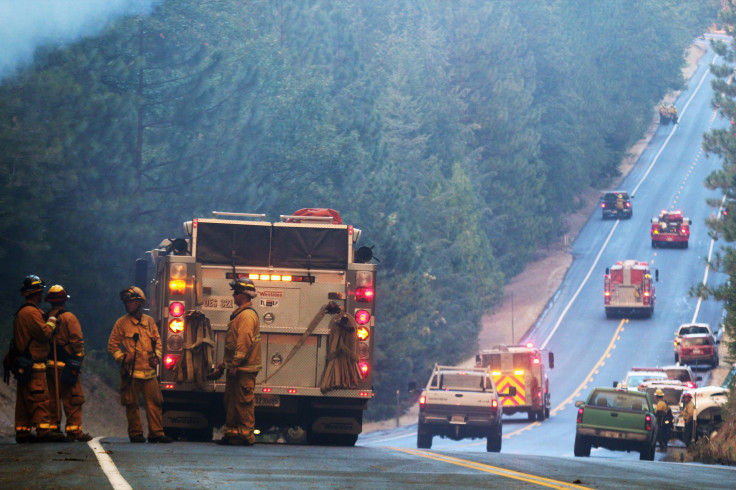Rim Fire Prompts Yosemite Tourist Warnings, Closures Over Labor Day Weekend

California’s two-week-old Rim Fire had long been merely a threat on the horizon to tourists at Yosemite National Park until smoke crept into Yosemite Valley just in time to cloud vacationers’ Labor Day weekend travel plans.
Officials closed down several roads and facilities in the popular national park Sunday and warned visitors to scale back on their outdoor recreation plans and avoid strenuous activity.
“Winds in the Yosemite area have been variable, causing periods of smoky conditions throughout much of Yosemite,” park officials stated Sunday. “When conditions are smoky, visitors to the area should avoid extended strenuous physical activities outdoors. Additionally, those that are sensitive to air quality impacts should avoid going outside in Yosemite.”
An air-quality reading from the Yosemite Valley Visitor Center Sunday afternoon came in at 87.5 micrograms per cubic meter, or “Unhealthy,” on the park’s five-part scale.
Beyond smoke concerns, Yosemite had several temporary closures in effect over the holiday weekend across the map. Officials shut the Big Oak Flat Road (the continuation of Highway 120 inside the national park) from the entrance station to Crane Flat, and closed all facilities and camping areas in the area. The only access to Yosemite Valley Sunday was via Highway 140 from Merced or Highway 41 from Fresno.
The Tioga Road from Crane Flat to Ten Lakes Trailhead will also remain closed through at least Monday, the park said on its website, with all facilities and camping areas along the road temporarily shut down. Similar closures were in place along the now-closed Hetch Hetchy Road and portions of Old Coulterville Road.
Yosemite National Park typically sees some 4 million visitors a year, more than 600,000 of whom arrive each August. With dozens of backcountry trails and several camping areas closed, however, the park was dealt a major blow on what should have been one of its busiest weekends. Moreover, popular holiday events such as the Strawberry Music Festival at Camp Mather just outside the park had to be canceled due to the fire at a loss of nearly 5,000 weekend guests.
Officials reported that attendance at the national park had noticeably dropped over the past two weeks, putting a damper on a summer season that many businesses had hoped would make up for last year’s hantavirus outbreak, which frightened away many would-be visitors.
Yet, it’s not all bad news for Yosemite. The most popular portions of the park remained open to the public Sunday, including the scenic waterfalls, granite domes and meadows of Yosemite Valley. Firefighters were also racing to secure Yosemite’s famed sequoia trees.
National Park Service Director Jonathan Jarvis told Agence France-Presse in a phone interview after surveying the affected areas that the Rim Fire “is not a catastrophe” for the park. “These trees are very old, and it’s not the first fire they’ve ever seen.” Low-intensity fires play a vital role in the reproductive cycle of the forest, releasing seeds and clearing the soil in which they germinate.
Officials said southwest transport winds would dominate for the next few days, keeping air quality in the Yosemite Valley and areas south of the fire in the good-to-moderate range. Areas to the north and northeast of the fire, including the Lake Tahoe Basin, will likely see greater impacts.
The California Department of Forestry and Fire Protection, or CAL FIRE, urged travelers statewide to be extra careful with their outdoor plans over the Labor Day weekend. “The past several weeks, our firefighters have been extremely busy up and down the state with major wildfires, including the over 200,000-acre Rim Fire burning near Yosemite National Park,” said Chief Ken Pimlot, director of CAL FIRE. “All summer long, the potential for wildfires has been much higher than normal, and this weekend is no different.”
The Rim Fire had burned 222,777 acres (348 square miles) of forest by Sunday morning, making it the fourth-worst wildfire in California history. Nearly 100 square miles of wilderness in Yosemite has been lost to the blaze since it burned into the remote northwestern corner of the park late last week, representing about 6 percent of Yosemite’s backcountry.
The U.S. Forest Service said the Rim Fire was about 40 percent contained Sunday, a slight improvement in the firefighters’ weeks-long effort. State officials put the cost to date of the Rim Fire at $60 million, and they said some 5,115 personnel were working diligently to put out the blaze, including nearly 700 specially trained California prison inmates. The initial cause of the fire, which began Aug. 17 in Stanislaus National Forest, remains under investigation.
A fire chief in the town of Twain Harte, west of Yosemite, speculated at a community meeting last week that the blaze was human-caused. “There’s no lightning in the area … We highly suspect that it might be some sort of illicit grove, marijuana grow-type-thing.” A YouTube video of that meeting has fueled speculation that the Rim Fire could be tied to marijuana growers with links to a Mexican drug cartel.
© Copyright IBTimes 2024. All rights reserved.






















